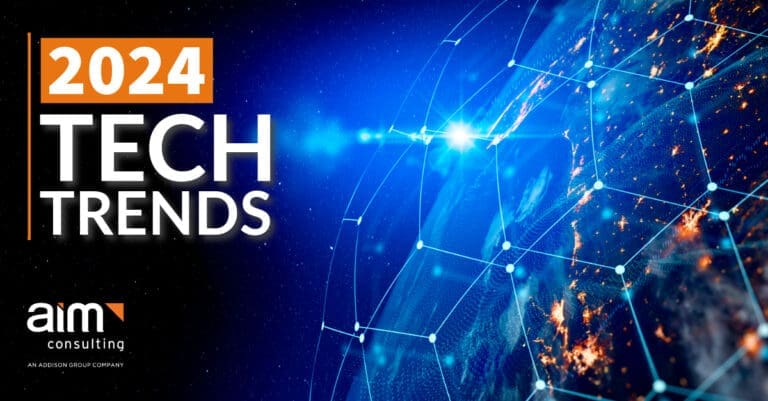
As we step into 2024, the tech landscape is buzzing with anticipation, echoing with promises of transformative technologies and innovations.
Amidst the promises and pitfalls, it’s essential to understand the evolving trends that will shape the tech industry in 2024. We spoke with thought leaders at AIM Consulting to learn the changes you should expect and how your organization can adapt accordingly.
Meet our experts:
- Patrick Taylor – National Technology Evangelist
- Jeff Rubingh – National Director, Digital Experience
Table of Contents:
- Overapplication of Large Language Models
- The Productivity Dividend of AI
- Challenges for Generative AI Early Adopters
- The Evolution of Consumer and Enterprise Generative AI
- The Generative AI Divide
- The Dark Side of AI: Social, Cultural, and Environmental Impacts
- Shaping the Future: Custom Solutions, Cloud Adoption, and Automation
- The Critical Role of DevEx
Overapplication of Large Language Models
Large language models (LLMs), such as GPT-4, garnered immense attention in 2023 and show tremendous, transformative long-term potential. Yet Patrick Taylor says that the incredible hype around AI will induce people to overapply it in 2024.
“LLMs can serve as an extremely powerful tool in the right circumstances,” Taylor shares, “but we are seeing organizations trying overapply it in situations where it’s not actually useful, meaningful, or at all necessary.”
He elaborates that there are some Copilots and LLMs that show incredibly exciting potential, but that does not mean they can be used in all possible applications.
LLMs and Generative AI are impressive and, when applied correctly, will undoubtedly give adopters a competitive edge. But trying to put AI into everything, Taylor warns, is a mistake.
The Productivity Dividend of AI
Rubingh shares his theory that in spite of the challenging economic circumstances the U.S. has encountered in the past two years and ongoing rumblings about an impending recession, the “hidden productivity dividend” of AI is what has enabled the U.S. economy to remain buoyant.
AI, Rubingh explains, is a pivotal force in enhancing productivity across the enterprise. Its ability to automate lower-value, time-consuming tasks can be a game-changer. This automation frees up employees to dedicate their efforts to projects of higher value and significantly elevates organizational efficiency.
The ripple effect of this shift is significant, leading to improved output quality, faster turnaround times, and, most importantly, an environment where innovation and strategic thinking can thrive.
Looking ahead to 2024, Rubingh projects a marked increase in the realization of this AI productivity dividend. As AI technologies continue to mature and integrate more seamlessly into various business processes, their impact on productivity will become increasingly evident. This progression will play a vital role in not just sustaining but accelerating economic growth, even in the face of global economic uncertainties.
Rubingh’s theory underscores the importance of AI in our current modern economic context. It highlights how AI’s capability to optimize productivity could be the linchpin that helps the U.S. economy navigate through turbulent times and emerge stronger in 2025.
Challenges for Generative AI Early Adopters
Taylor shares that the excitement around LLMs and Generative AI will continue to cause some chaos while organizations joust for dominance in 2024. The need to move fast and aggressively to secure market share in such an open, competitive landscape causes some providers to demo and release LLMs and Copilots that do not consistently deliver a successful outcome.
When Generative AI gets it right, it’s incredible – but it cannot be counted upon to be flawless. There have been numerous instances of news organizations and media companies publishing inaccuracies or outright nonsense written by LLMs, and this trend is likely to continue.
Taylor encourages technologists to remember that with LLMs, as with any other revolutionary technology, the power of the technology does not absolve us from the responsibility of what we put out to the world. Yet when early adopters do harness the power of LLMs safely and effectively, the competitive edge and value they gain from doing so will be significant.
AIM Consulting is using LLMs and copilots today to add insight and efficiency to authoring code and to hiring talented contributors. We have found that understanding how to apply this technology judiciously can make radical improvements to your business while maintaining safety and quality.
“I’m not saying AI is a bunch of smoke,” says Taylor. “It’s incredibly useful, and its potential is only poised to grow, but one of the big trends that’s going to happen in 2024 is people are going to start to recognize the limits of what’s available today rather than the promise of what is going to come tomorrow.”
This is one of the most profound benefits of partnering with organizations like AIM Consulting. Our technology experts can cut through the hype and make practical, reliable, valuable solutions out of systems on which the paint is still drying.
The Evolution of Consumer and Enterprise Generative AI
Rubingh notes 2023 was the first year of truly recognizing what Generative AI is and the power it brings to the consumer. The proliferation of the capabilities of large language models has been transformative, and consumers have adopted it in droves.
Fast on its heels has been the capabilities of large generative image models. These capabilities will continue to grow tremendously in 2024. “There’s a huge opportunity for OpenAI and other model purveyors to productize Generative AI capabilities into features other than just a chat interface,” he shares.
On the enterprise side, Rubingh says, adoption will gain significant momentum. Enterprises are increasingly integrating Generative AI to revolutionize areas like creativity, customer service, and data analysis.
This technology streamlines design and content generation, enhancing efficiency and innovation. Customized customer interactions and personalized retail experiences will become more prevalent, thanks to AI’s data processing capabilities.
However, Rubingh notes, this adoption brings challenges, including managing ethical implications and adjusting to evolving regulatory standards. Investment in IT infrastructure and skilled personnel is essential for effective implementation.
Moreover, enterprises will need to focus on robust cybersecurity measures to safeguard against new AI-related threats, ensuring a secure and productive integration of Generative AI technologies.
“A business’s success in implementing effective AI governance will determine their effectiveness at implementing AI across their business as measured by their customer’s trust and satisfaction.”
Matt Bomberger
Director of Data & Analytics, AIM Consulting
The Generative AI Divide
Rubingh projects in 2024, we will see contrasting perspectives on several aspects of Generative AI.
Effective Altruism vs. Effective Accelerationism
The debate between Effective Altruism (EA) and Effective Accelerationism (e/acc) in AI circles in early 2024 represents two divergent philosophies on the advancement of artificial intelligence.
Effective Altruism in AI emphasizes cautious, evidence-based, and ethical AI development. It prioritizes societal well-being and the optimization of AI’s benefits for humanity, advocating for a responsible and thoughtful approach to AI advancement. This perspective is focused on balancing technological progress with the potential risks and ethical implications of AI.
In contrast, Effective Accelerationism advocates for a rapid and largely unrestricted development of AI. It is rooted in techno-libertarian ideals and promotes technological progress without barriers. Proponents believe the advantages of AI vastly outweigh the potential harms, advocating for a scenario where AI evolves freely and rapidly. This approach draws from various philosophies and suggests a transformative potential for AI innovation and commercialization.
The debate reflects broader discussions about AI’s role in society, where Effective Altruism represents a cautious and ethical stance, and Effective Accelerationism pushes for unfettered progress. These differing viewpoints will be crucial in shaping the future direction of AI technology and its societal integration.
David vs. Goliath
In the evolving landscape of Generative AI, a classic ‘David vs. Goliath’ scenario is unfolding, as described by Rubingh. OpenAI, a relatively small player, launched ChatGPT, rapidly becoming the fastest-growing application ever, captivating global attention. This development has sparked a competitive race among large tech conglomerates to match the pace and innovation of nimble entities like OpenAI and Anthropic.
Despite their vast resources and extensive computing capabilities, these tech giants find themselves in a pursuit to match the agility and creative edge of these smaller AI startups. In 2023, OpenAI’s ChatGPT remarkably dominated the market, securing a 60% share and attracting an impressive 14.68 billion visits from September 2022 to August 2023. This dominance is a testament to the innovative approach and tactical agility of smaller companies in the AI space.
Looking ahead to 2024, Rubingh foresees this competitive dynamic intensifying. The battle for Generative AI market share is expected to continue, with smaller players leveraging their creativity and flexibility, while the larger firms utilize their vast resources and global reach.
This rivalry promises to drive significant advancements and diverse offerings in the Generative AI market, shaping the future of technology.
Legacy vs. Startup Tech Companies
In the context of the dynamic AI landscape, Rubingh highlights a compelling juxtaposition between established legacy companies and burgeoning startups, intensified by the latest surge in AI advancements. He predicts the emergence of thousands of startups, inspired by the new wave of AI technology, particularly in Generative AI and large language and image models.
“We’re seeing most of the VC money headed straight towards this new market. It’s an incredible era of startups for Generative AI and large language models and large image generation models,” says Rubingh. This surge, he suggests, is fueling a remarkable era of innovation and growth in the AI sector.
Startups, with their fresh perspectives and deep understanding of applying AI in specialized domains, are poised to unlock extraordinary productivity and unveil breakthroughs that hint at the vast, untapped potential of Generative AI.
However, Rubingh also points out a critical challenge faced by these startups: the dominance of NVIDIA in the chip market, coupled with the high costs associated with their products. This situation presents a potential hurdle for startups, potentially constraining their capacity to compete and innovate within the fast-paced and resource-intensive realm of AI development.
The balance between these emerging startups’ innovative potential and the resource constraints they face will be a key factor in shaping the AI industry’s trajectory.
The Dark Side of AI: Social, Cultural, and Environmental Impacts
Beyond the allure of artificial intelligence lies a darker reality – the colossal power consumption of AI systems. Taylor highlights the astronomical electricity requirements to build AI models and the ethical concerns related to human labor in data classification.
The global digital divide widens as some organizations resort to extremely low-wage “classification sweatshops” in the global South to fuel AI training data.
Moreover, Taylor projects the conversation in 2024 will shift toward equity and implicit bias in AI systems. He calls attention to the fact that AI is “neither artificial nor intelligent” in the sense that it heavily relies on human effort and often reflects the biases present in its training data.
The justice elements of AI, at every layer and across every industry, are set to receive increased scrutiny.
Shaping the Future: Custom Solutions, Cloud Adoption, and Automation
A continuing shift towards more custom solutions and flexible Software as a Service (SAAS) solutions will accelerate in 2024, shares Taylor. Companies like Salesforce, Shopify, and Microsoft Dynamics which offer flexible and reliable systems for customer relationship management with less historical baggage, will continue to set the tone for future innovations. He projects this is a trend that will continue to grow and evolve in 2024 and beyond.
The overarching trend of cloud adoption continues, with a focus on applications moving up the stack. Copilots and LLMs represent a broader shift toward thinking of applications as solutions rather than technologies. Automation, exemplified by tools like Microsoft Power Automate, Zapier, and If This Then That, is becoming more sophisticated, reliable, and user-friendly.
The dream of drag-and-drop software development is poised to become more of a reality in 2024, shares Taylor, aided by machine learning and Copilots.
“In an era of tightening budgets and growing demands on workforces with limited resources on hand, automation is the key to achieving more with less and maximizing efficiency.”
Tish St. Germain
Director of Delivery Leadership, AIM Consulting
The Critical Role of DevEx
The significance of developer experience will reach unprecedented heights this year, shares Taylor. In this rapidly evolving technical landscape, where speed and agility are paramount, a streamlined development process facilitated by an intuitive and supportive environment is crucial.
DevEx is an emerging philosophy that focuses on the people who write the software. It is exceptionally valuable to look at the feedback, the cognitive load and the opportunities for flow that we give to software developers. This concept was published in 2023 by the Association of Computing Machinery and will drive a large trend in the most successful companies in 2024.
Companies that prioritize and invest in enhancing the developer experience not only foster a culture of innovation but also gain a competitive edge in delivering high-quality products swiftly to market.
“The focus on giving developers the tools they need and the environment they need to be their most productive selves is going to be a big differentiator. Companies that take that on are going to win,” says Taylor.
Transformative Technology in 2024 and Beyond
Navigating the shifting technology landscape in 2024 will bring both excitement and challenges, but understanding the trends ahead can empower your organization to gain a competitive edge and pave the way for a more responsible and innovative future.
When your organization looks to achieve your most ambitious initiatives across data, digital, and cloud this year, AIM Consulting can help. Our value is anchored in deep expertise in technology and a passion for empowering our clients’ growth and success.
Let’s build the future together.
Ready to Embrace the Latest Developments in Technology?
We are technology consulting experts & subject-matter thought leaders who have come together to form a consulting community that delivers unparalleled value to our client partners.





